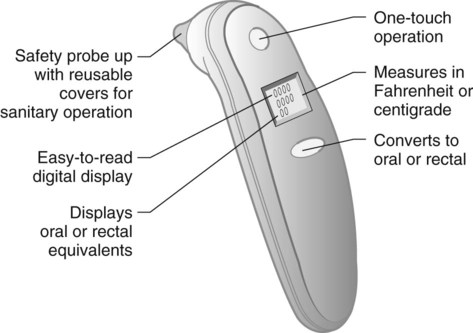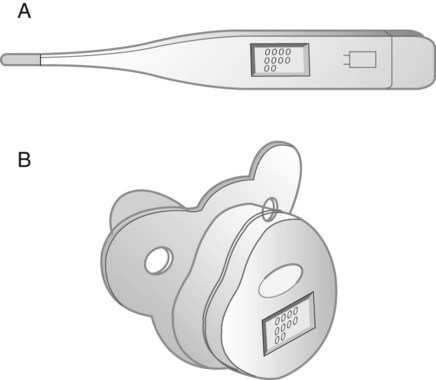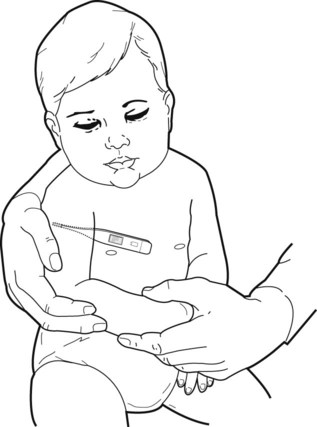This section may be photocopied and distributed to families. You should measure a child’s temperature: 1. When the skin feels warm to your touch 2. When the child is not acting like his usual self 3. Before calling your health professional to say that the child is sick Digital thermometers are used just like glass mercury thermometers, but they are safer and much easier to read. They have a button battery-powered heat sensor that measures temperature in less than 1 minute. The temperature is displayed in numbers on a small screen (Figure 1). Digital thermometers are also available within a pacifier. As your child sucks on the pacifier, the temperature is shown on a screen. Read the manufacturer’s directions for the length of time to keep the pacifier in the mouth. Ear thermometers use a probe that is placed in the opening of the ear to measure the temperature of the eardrum (Figure 2). Although this device is expensive, it is easy to use, rapidly measures temperature (in about 1 second), and causes no discomfort to your child, and its use does not require your child’s cooperation. However, an ear thermometer must be used correctly for accurate results. The current models are not considered to be accurate for detecting fever in infants and toddlers. Read the manufacturer’s instructions for how to place the probe in the ear canal and how to tug the earlobe. Tugging the earlobe straightens the ear canal so the probe can measure the temperature of the eardrum. As a general rule, for children younger than 3 years, pull the bottom of the earlobe down and back. For children older than 3 years, pull the top of the earlobe up and back. Measuring temperature in the axilla (armpit) is the safest way to check if your child has a fever. 1. Tell the child that you are going to measure his temperature. 3. Look at the thermometer to make sure it is reading below 96° F. 4. Place the thermometer under the child’s arm. The thermometer’s tip should rest in the center of your child’s armpit (Figure 3).
Wilson & Hockenberry: Wong’s Clinical Manual of Pediatric Nursing, 8th Edition
Patient Teaching Guide
Measuring Your Child’s Temperature
Digital Thermometers
Ear Thermometers

How to Measure Axillary Temperature
![]()
Stay updated, free articles. Join our Telegram channel

Full access? Get Clinical Tree


Wilson & Hockenberry: Wong’s Clinical Manual of Pediatric Nursing, 8th Edition: Patient Teaching Guide
Get Clinical Tree app for offline access


